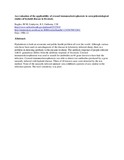| dc.contributor.author | Kagiko, M M | |
| dc.contributor.author | Lindqvist, K J | |
| dc.contributor.author | Gathuma, J M | |
| dc.date.accessioned | 2013-06-13T09:02:27Z | |
| dc.date.available | 2013-06-13T09:02:27Z | |
| dc.date.issued | 1986-12 | |
| dc.identifier.citation | Kagiko, M. M, Lindqvst, K.J &Gathuma, J.M(1986).An evaluation of the applicability of crossed immunoelectrophoresis in seroepidemiological studies of hydatid disease in livestock. International journal of Zoonoses; 13(4): 230-5. | en |
| dc.identifier.issn | 0377-0168 | |
| dc.identifier.uri | http://www.ncbi.nlm.nih.gov/pubmed/3557834 | |
| dc.identifier.uri | http://erepository.uonbi.ac.ke:8080/xmlui/handle/123456789/32841 | |
| dc.description | Journal article | en |
| dc.description.abstract | Hydatidosis is both an economic and public health problem all over the world. Although various tests have been used on serodiagnosis of the disease in laboratory infected sheep, there is a problem in detecting antibody to the parasite in sheep. The antibody response of people infected with E. granulosus differs from the antibody response of livestock. Crossed immunoelectrophoresis was used to search for antibodies in 44 goats known to have had the infection. Crossed immunoelectrophoresis was able to detect two antibodies produced by a goat naturally infected with hydatid disease. Three of 44 known cases were detected by the test method. None of the naturally infected animals' sera exhibited a pattern of arcs similar to the reference pattern. The test's sensitivity was poor. | en |
| dc.language.iso | en | en |
| dc.subject | Crossed immunoelectrophoresis | en |
| dc.subject | Seroepidemiological studies | en |
| dc.subject | Hydatid disease | en |
| dc.subject | Livestock | en |
| dc.title | An evaluation of the applicability of crossed immunoelectrophoresis in seroepidemiological studies of hydatid disease in livestock. | en |
| dc.type | Article | en |
| local.publisher | Department of Public Health, pharmacology and Toxicology, University of Nairobi | en |

